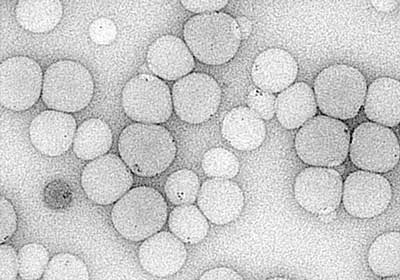| Jan 22, 2019 | |
New applications for encapsulated nanoparticles with promising properties(Nanowerk News) Nanotechnology and nanoscience are disciplines in which minute molecular structures with special physical and chemical properties are designed, manufactured and studied. One of the types of particles that are studied in these disciplines are quantum dots; they are semiconductor nanocrystals the size of which ranges between 2 nm and 10 nm and which have excellent optical and electronic properties. Worthy of mention is the fact that they emit light in different colours depending on their size, in other words, "the emission wavelength is varied just by varying the size of the nanocrystal, without modifying its composition," explained Alicia de San Luis, a POLYMAT researcher and author of this work (Israel Journal of Chemistry, "PS/PMMA-CdSe/ZnS Quantum Dots Hybrid Nanofibers for VOCs Sensors"). |
|
 |
|
| Microscopic image of quantum dots (dark points) encapsulated in polymer particles. (Image: Dr Mariano Barrado / UPV/EHU) | |
| The properties of quantum dots render them potentially useful for a range of applications, such as detection in biomedicine, the production of solar panels and LEDs, their use as sensors of volatile organic compounds (VOCs), and as photosensitizers. Yet, "their drawbacks also need to be taken into consideration: they are difficult to handle owing to their small size, and are toxic, given that the quantum dots of higher quality mostly consist of heavy metals," pointed out the researcher. | |
| To get the most out of the excellent optical properties of these nanoparticles, while not forgetting the toxicity problems they have, at the UPV/EHU's Polymat institute of research they have managed to efficiently encapsulate commercial quantum dots into polymer particles dispersed in water while maintaining the fluorescence of the quantum dots over long periods of time. | |
| "The main aim was to encapsulate the quantum dots into slightly larger polymer particles to protect them and, at the same time, be able to handle them without them losing their properties," as the author of the research pointed out. "We have implemented a simple method yielding good results: polymer particles with fluorescence stable over a minimum of 9 months," she added. | |
Different combinations and applications |
|
| Having achieved the first aim, "the second step was to encapsulate combinations of quantum dots of varying sizes to create a bar code that could be used for multiple detection in biological systems," she explained. That way they managed to control the fluorescence of these combinations, since by using quantum dots that emit at different wavelengths, "their signals can be detected simultaneously without one being superimposed on another one". | |
| This could be useful for biomedical detection as there is a possibility of modifying the surface of the polymer particle with different analytes (or different antibodies or antigens). In the researcher's view, "it is a pretty powerful, straightforward, fast detection technique. Most labs have a fluorometer and, what is more, one would not have to wait several days to process the sample". | |
| They also explored the combining of quantum dots with other inorganic nanoparticles (CeO2) by co-encapsulating them into the same polymer particles. In this study they were able to see "an increase in the emission of fluorescence during the time they were exposed to sunlight". | |
| Finally, in the research they tackled the possible applicability of a range of synthesised combinations, such as optical and electrical sensors of volatile organic compounds (VOCs) by producing nanofibres and subsequently putting them in contact with VOCs. This part of the research is being carried out in collaboration with Tecnalia. "In this case we are working on fluorescence as well as on conductivity measurements of the nanofibres," explained Alicia de San Luis. |
| Source: University of the Basque Country | |
|
Subscribe to a free copy of one of our daily Nanowerk Newsletter Email Digests with a compilation of all of the day's news. |
